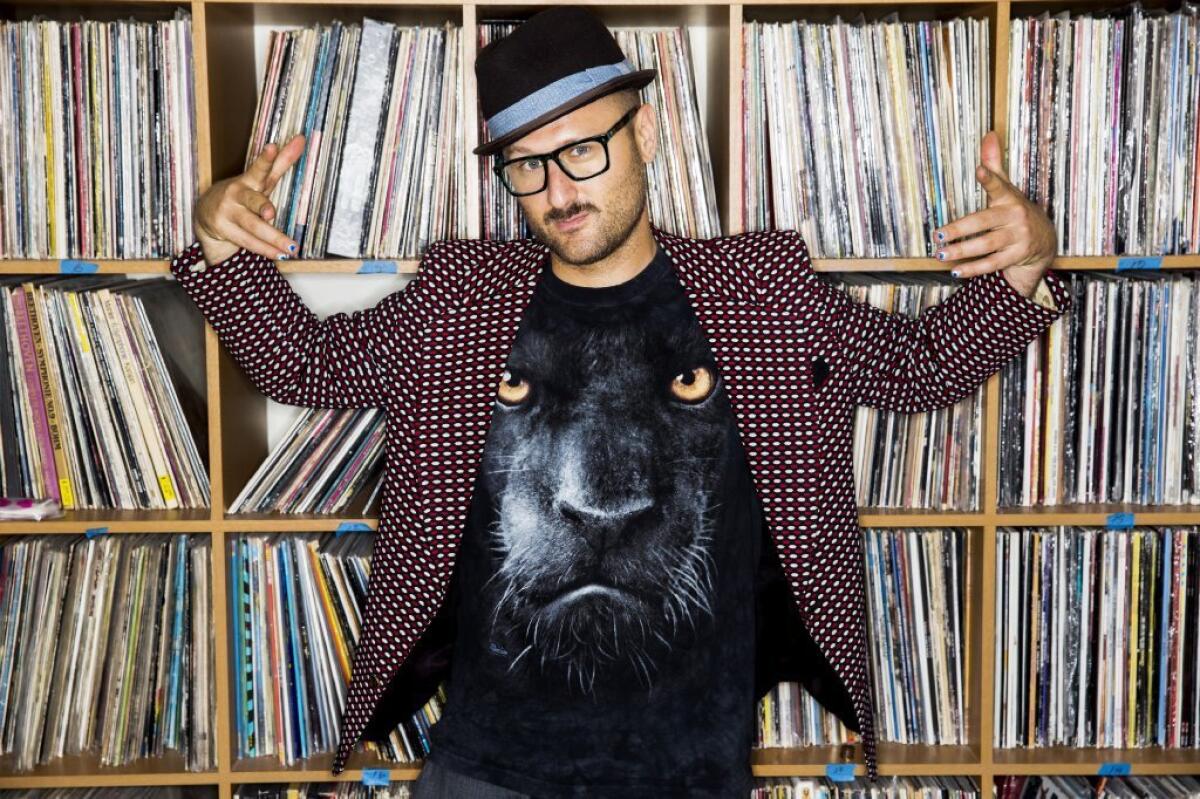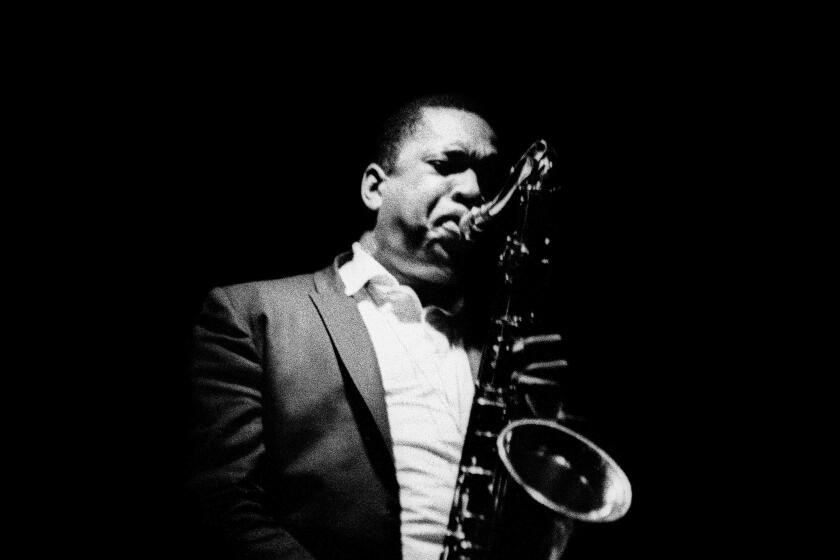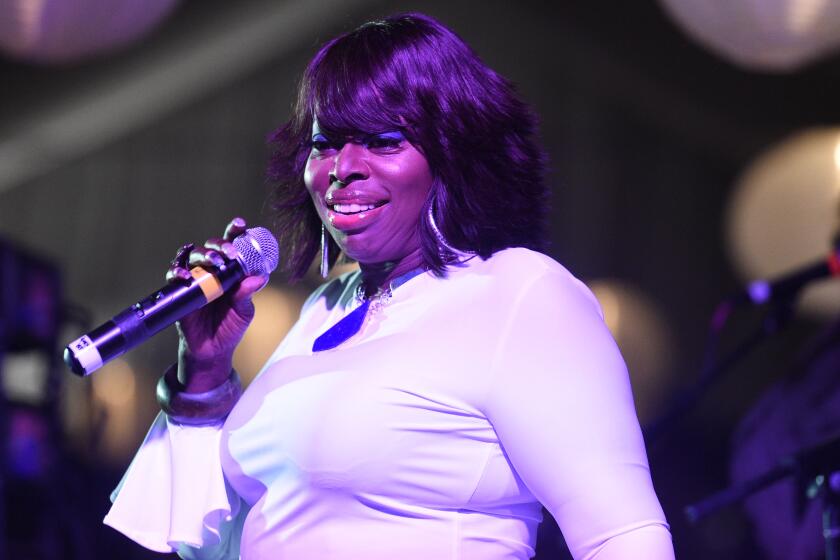Sam Spiegel turns odd musical pairings into a winning formula

- Share via
Musician and producer Sam Spiegel lives in a wooden A-frame house in the Hollywood Hills. It’s a beautiful place, but its best feature is an apropos (if possibly apocryphal) history of weird musical collaboration.
“The guy who sold it to me says he has a picture of Jimi Hendrix in a dashiki jamming in here with David Crosby,” he said. “Allegedly, though. He’s never shown it to me.”
If it’s true, the story fits him. Spiegel is a contemporary kind of artist — a musician, record producer and general-idea-guy whose work exists almost only in tandem with someone else’s. He’s a musical polymath who coaxed a nebula of superstars (David Byrne, Kanye West, Tom Waits) into cameos with his bands N.A.S.A. and Maximum Hedrum. The latter just wrapped up a tour opening for Yeah Yeah Yeahs.
PHOTOS: Concert photos by The Times
As producer and DJ Squeak E. Clean, he’s worked alongside West, Crystal Castles, Kesha and Maroon 5; he’s also a commercial-friendly mixed composer (Google, Puma, Smirnoff) and alt-opera composer and the kind of guy whom you meet at a Hollywood house party and are sort of confused about what exactly he does for a living but you want to work with him on something, anything, nonetheless.
The vibe in Spiegel’s house is half Alpine, half ashram, with a haphazard couch made of cushions on the floor and floor-to-ceiling windows overlooking the hills. There’s a drum set and full recording rig in the living room, where the 33-year-old (and brother of director Spike Jonze) does much of his musical work.
Plonking down on a pile of pillows, he’s quick to recount the origins of his latest project, the synth-rock combo Maximum Hedrum, which he formed with Sepultura singer Derrick Green and the ‘80s action-movie soundtrack savant Harold Faltermeyer. You’d know the latter from his themes to “Top Gun” and “Beverly Hills Cop,” whose synth plucks are synonymous with big-budget, Reagan-era shootouts.
“He’s such a genius,” Spiegel said. “We met while we were working on the Kevin Smith movie ‘Cop Out’ together, and he was so funny, he’s got so many stories from the ‘80s of cocaine and private jets and Giorgio Moroder.”
It takes a certain sinister mind to think to pair that aesthetic with Green, the lead singer of the legendary Brazilian thrash-metal band Sepultura (here moonlighting as a ‘70s funk crooner). But to judge by their capacity-packed January residency at the Silver Lake club Los Globos, it clicked. That’s how Spiegel’s musical mind works — finding the odd grooves of other artists and ideas, and making them fit in strange and zeitgeisty ways of his own.
That method came to its most involved fruition in 2011 when he worked closely with Yeah Yeah Yeahs singer Karen O on her long-simmering opera project “Stop the Virgens,” which he co-music-directed with that band’s guitarist, Nick Zinner. Speigel had worked with the band before, producing its second album “Show Your Bones” in 2006. But “Virgens” was a genre-exploding mix of opera, video art, noise-rock volatility and high-fashion downtown extravagance from Karen O’s longtime designer Christian Joy. It played at Sydney’s famed Opera House and was a high point in Spiegel’s career in making sense of many sharp aesthetic edges.
“Sam is great because he’s up for anything and at the same time he takes being up for anything very seriously,” said Karen O via email. “Sam’s fun factor breaks down walls, which is probably why he can work with so many different kinds of artists, the scientist in him fuses it altogether into a winning formula.”
He’s perhaps best known for his ongoing N.A.S.A. endeavor with the Brazilian DJ Zegon, an omnivorous beast of a crate-digging band that took Spiegel across continents to field-record with an absurd swath of legends and underground artists; Ol’ Dirty Bastard and David Byrne will probably never meet on an album again, as they did on N.A.S.A’s 2009 LP “The Spirit of Apollo.”
PHOTOS: Celebrity portraits by The Times
“People are generally more open to collaborating than you think,” he said. “Tom Waits doesn’t usually get asked to be on a hip-hop record.”
Lest one think that Speigel has arrived at some kind of hipster samsara of only playing in bands with his heroes, he’s also tapped an enviable vein of commercial work. In 2010 he commandeered New York’s Standard Hotel for a Target-sponsored installation in which each room was a mini-exhibition of avant-garde lighting, freaky beat music and fast fashion (he’s also worked on a host of video game scores, film and commercial soundtracks).
To Speigel, it’s all on one continuum, where he takes a slate of artistic requirements — either a company’s or a collaborator’s — and makes some kind of interesting sense out if it all.
“The role of a musician has changed,” he said. “It’s a lot harder to be a professional musician today and people are more accepting of commercial applications; it just doesn’t have a stigma for me. I mean, Target gave me a whole building with lights and dancers and just said, ‘We want a spectacle, go.’ I felt like they were the Medicis.”
As L.A. archetypes go, Spiegel is a fine one to aspire to — a life as a genial guy with a bottomless well of musical ideas he can apply across many platforms. But is there any idea that’s truly his, and his alone? Can an artist whose chief talent is making other artists’ styles and visions fit together make something all his own?
Turns out, yes. But appropriately, it’s a whole other kind of group effort.
“I’ve got a film in mind,” he said. “I can’t talk about it, but I have the story. I love film and I’ve always wanted to make one.”
More to Read
The biggest entertainment stories
Get our big stories about Hollywood, film, television, music, arts, culture and more right in your inbox as soon as they publish.
You may occasionally receive promotional content from the Los Angeles Times.











